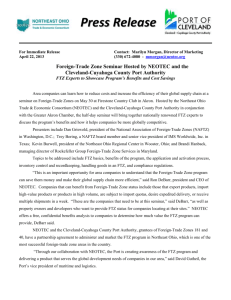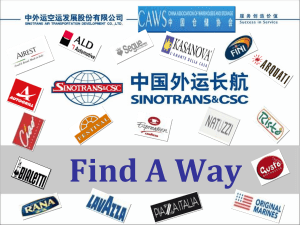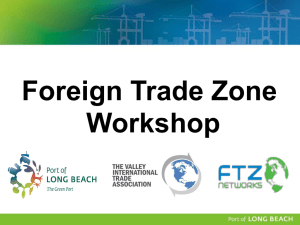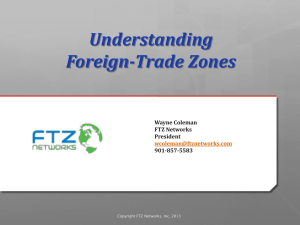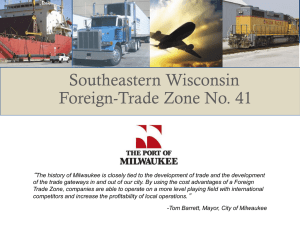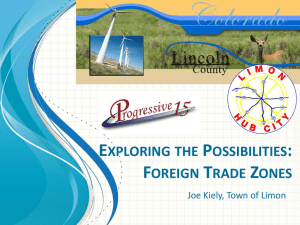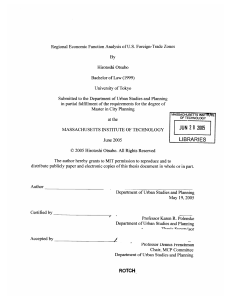Foreign Trade Zone
advertisement
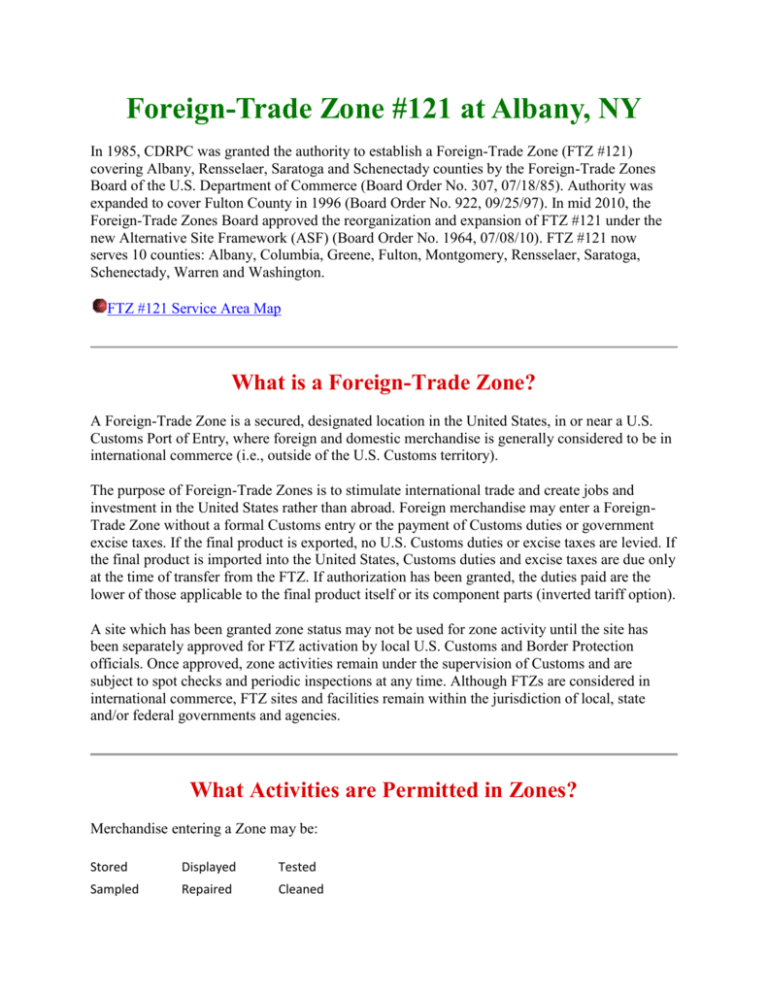
Foreign-Trade Zone #121 at Albany, NY In 1985, CDRPC was granted the authority to establish a Foreign-Trade Zone (FTZ #121) covering Albany, Rensselaer, Saratoga and Schenectady counties by the Foreign-Trade Zones Board of the U.S. Department of Commerce (Board Order No. 307, 07/18/85). Authority was expanded to cover Fulton County in 1996 (Board Order No. 922, 09/25/97). In mid 2010, the Foreign-Trade Zones Board approved the reorganization and expansion of FTZ #121 under the new Alternative Site Framework (ASF) (Board Order No. 1964, 07/08/10). FTZ #121 now serves 10 counties: Albany, Columbia, Greene, Fulton, Montgomery, Rensselaer, Saratoga, Schenectady, Warren and Washington. FTZ #121 Service Area Map What is a Foreign-Trade Zone? A Foreign-Trade Zone is a secured, designated location in the United States, in or near a U.S. Customs Port of Entry, where foreign and domestic merchandise is generally considered to be in international commerce (i.e., outside of the U.S. Customs territory). The purpose of Foreign-Trade Zones is to stimulate international trade and create jobs and investment in the United States rather than abroad. Foreign merchandise may enter a ForeignTrade Zone without a formal Customs entry or the payment of Customs duties or government excise taxes. If the final product is exported, no U.S. Customs duties or excise taxes are levied. If the final product is imported into the United States, Customs duties and excise taxes are due only at the time of transfer from the FTZ. If authorization has been granted, the duties paid are the lower of those applicable to the final product itself or its component parts (inverted tariff option). A site which has been granted zone status may not be used for zone activity until the site has been separately approved for FTZ activation by local U.S. Customs and Border Protection officials. Once approved, zone activities remain under the supervision of Customs and are subject to spot checks and periodic inspections at any time. Although FTZs are considered in international commerce, FTZ sites and facilities remain within the jurisdiction of local, state and/or federal governments and agencies. What Activities are Permitted in Zones? Merchandise entering a Zone may be: Stored Displayed Tested Sampled Repaired Cleaned Salvaged Destroyed Relabeled Repackaged Manipulated Mixed Processed Assembled Manufactured Manufacturing, processing and any activity that results in a change of the tariff classification must be specifically approved by the FTZ Board. Retail trade is prohibited in zones. What Kind of Merchandise can be Placed in a Zone? Any merchandise that is not prohibited from entry into the U.S. may generally be admitted into a Zone. Although FTZs are considered in international commerce, FTZ sites and facilities remain within the jurisdiction of local, state and/or federal governments and agencies. If applicable, import licenses or permits from other government agencies may still be required. Products may be excluded if agencies determine that zone facilities are inadequate for storage and handling requirements. Products which are deemed detrimental to public health, interest or safety may be excluded by the Foreign-Trade Zones Board. Similarly, the Board may place restrictions upon the zone status and type of operation that may be performed upon certain merchandise. What are the Advantages of Using a Foreign-Trade Zone? The benefits associated with zone use will vary depending upon the type of operation involved and authority granted by the Foreign-Trade Zones Board and Customs. Zones may provide some or all of the following benefits: Duty Exemption: no duties or quota charges on re-exports (exception applies for exports to Canada and Mexico under NAFTA). By using a Foreign-Trade Zone, the company avoids the lengthy Customs duty drawback process. No duty is paid on goods destroyed in the zone, which can benefit a company with fragile imports or with manufacturing processes that result in large amounts of scrap. Duty Deferral: Customs duties and federal excise tax deferred on imports until they leave the zone and enter the U.S. Customs territory. (Zone merchandise may move in-bond, Zone-to-Zone transfers without payment of duty.) Unlike bonded warehouses or temporary importing under bond programs, there is no limit on the length of time that merchandise may remain within the Zone, whether or not duty is owed. Duty Reduction (Inverted Tariff): Where zone manufacturing results in a finished product that has a lower US Harmonized Tariff rate than the rates on foreign inputs, the finished product may be entered into the U.S. Customs territory at the duty rate that applies to its finished condition. Moreover, duty is not owed on labor, overhead or profit attributable to zone production operations. Other Cash Flow Benefits: Harbor Maintenance Fee is paid quarterly instead of at the time imports arrive. Merchandise Processing Fees are paid at the time goods leave the zone. Merchandise Processing Fee (MPF) Reduction: MPF is only paid on goods entering the U.S. Customs territory. Zone users are able to file a single entry for all goods shipped from a zone in a consecutive seven day period instead of one entry file for each shipment (excluding merchandise subject to live entry). MPF fees are charged at 0.21% of the Total Estimated Value (TEV) of the shipment, with a maximum fee of $485 per entry. Fewer entry filings can also reduce Brokerage fees. Streamlined Logistics: Upon approval from Customs, imports may be directly delivered to the zone. Users may also request permission to break and affix Customs seals. A single entry may be filed for seven consecutive days worth of entries and exports. Quota Avoidance: In most instances, imports subject to quota may be retained within a ForeignTrade Zone once a quota has been reached allowing zone users access to potentially discounted inputs and the ability to admit merchandise as soon as a new quota year starts. Additionally, except for certain textiles, inputs subject to quota may be manipulated or manufactured while in the zone into a product not subject to a quota. Other Benefits: Better inventory control and security lead to better compliance with CBP requirements; Customs supervision may result in lower security and insurance costs. Duty payable on FTZ merchandise does not need to be included in the calculation of insurable value, again lowering insurance costs. Reduced transportation costs may also result from streamlined logistics. What are the Differences Between a Foreign-Trade Zone and a Bonded Warehouse? A Foreign-Trade Zone is considered outside the Customs territory and Customs entries are filed when goods are removed from the Zone. Firms using an FTZ may file weekly entries, saving on administrative work and potentially MPF. Bonded Warehouses are within the Customs territory and entries must be filed at the time goods enter the warehouse. A customs bond is not required for goods entering an FTZ; all admissions are covered under an FTZ operator’s Customs Bond, whereas Customs Bonds are required for all Bonded Warehouse entries. Foreign and domestic merchandise may be placed within an FTZ, whereas only foreign merchandise may be placed in a Bonded Warehouse. Goods can be stored indefinitely in an FTZ, whereas merchandise may only be stored within a Bonded Warehouse for a maximum of 5 years. Goods may be manufactured in an FTZ and firms may take advantage of inverted tariff and scrap, thereby lowering duty. Manufacturing is not permitted in a Bonded Warehouse and the total value of the merchandise is determined for duty purposes at the time goods enter the Warehouse. Duty is paid on the value of the entire shipment including any damaged goods or scrap. An FTZ has full control of merchandise allowing 24 hour a day movement and manipulation. Movement of goods into and out of an FTZ is relatively unrestricted. Customs has primary control of goods within a Bonded Warehouse and goods can only be inspected and transferred during regular working hours, moreover, movement is much more limited within a Bonded Warehouse and specific Customs authorization is required for every movement. What are the Costs Associated with Using a Foreign-Trade Zone? Applications for Usage-Driven sites, Subzones and Manufacturing are subject to fees, which vary according to the type of site and authority sought (see Foreign-Trade Zones Board website for application fees: http://www.ia.ita.doc.gov/ftzpage/applications.html . Applications are free for firms seeking warehousing and distribution authority within an established Magnet Site. Additionally, FTZ #121 charges administrative fees for sponsoring applications, preparing grantee agreements, and activations. FTZ #121 also charges an annual fee based on the type of operation and site activity. Revised FTZ # 121 – The Capital District Foreign-Trade Zone Tariff Operator Fees for All Sites Activated for Warehousing Only Annual Fee Schedule for Activated Operators with Warehousing Authority Less than 20,000 sq. ft. of Activated Zone Space $ 1,000 20,000 – 50,000 sq. ft. $ 2,500 >50,000 – 100,000 sq. ft. $ 5,000 >100,000 – 250,000 sq. ft. $ 7,500 More than 250,000 sq. ft. $10,000 Includes Traditional General-Purpose Zone, Magnet, UsageDriven, & Subzone Sites Special Annual Fees for Operators of Non-Activated UsageDriven & Subzone Sites First Year $ 0 Second Year Forward $ 2,000 Operator Fees for All Sites with Manufacturing Authority Special Annual Fees for Non-Activated Operators with Manufacturing Authority First Year $ 0 Second Year Forward $ 4,000 Annual Fee Schedule for Activated Operators with Manufacturing Authority Less than 20,000 sq. ft. of Activated Zone Space $ 2,500 20,000 – 50,000 sq. ft. $ 5,000 >50,000 – 100,000 sq. ft. $ 7,500 >100,000 – 250,000 sq. ft. $10,000 More than 250,000 sq. ft. $12,500 Includes Traditional General-Purpose Zone, Magnet, UsageDriven, & Subzone Sites One-Time Administrative Fees* Late Annual Report Information Starting 42 Days Before FTZB Due Date $100/day Grantee Agreement & Activation Fee $ 1,500 Sponsorship of Major Boundary Modification Application $ 6,000 Sponsorship of Scope of Authority Request** $ 4,000 *Administrative Fees do not include any applicable FTZ Board fees or the expense of preparing applications except for Minor Boundary Modification applications. **Scope of Authority may include Manufacturing/Processing Authority, Capacity Increases, Source Changes, Manufacturing Process Changes, etc. Revised 17 Dec 08 — Effective 1 Jan 09 Any company interested in pursuing zone procedures should perform a cost-benefit analysis. Although costs will vary depending upon the type of operation and industry, there are costs associated with all Zone operations which will include such items as: annual fees, annual report preparation time, inventory software and security. Industry experts vary on the amount of estimated savings that must be reached to make Zone operations worthwhile. Harmonized Tariff Schedule of the U.S. (Link) What are the types of zone sites available in FTZ #121? Magnet Sites are located at designated ports and industrial parks. These are open to multiple users and some will build to suit. Although manufacturing and processing activities can occur within these sites, the most common activities involve warehousing and distribution. No ForeignTrade Zone Board application is needed to establish a warehousing or distribution operation within a magnet site. Manufacturing and processing activities require the firm to file a detailed application with the Foreign-Trade Zones Board for authorization. Manufacturing applications typically take 9-12 months to process and must demonstrate a significant public benefit. Usage-Driven Sites can be established anywhere within the 10-county service area and are designated for a company ready to pursue FTZ activity. The designation is tied to a specific company and is limited to the space needed by the company for zone activities; however it is expected that there are other industrial/commercial spaces nearby that might benefit from Zone use at some time in the future. Usage-Driven sites allow the FTZ program to be flexible in accommodating firms that cannot move to Magnet Sites. A short application is required to establish the site; the Foreign-Trade Zones Board takes 30-45 days to process these applications. Although manufacturing and processing activities can occur within these sites, the most common activities involve warehousing and distribution. Manufacturing and processing activities require the firm to file a separate, detailed application with the Foreign-Trade Zones Board for authorization. Manufacturing applications typically take 9-12 months to process and must demonstrate a significant public benefit. Subzones are special-purpose zones, usually at manufacturing plants or distribution facilities that are not located near to other industrial/commercial space. Subzones are approved for use by one company for a specific activity. Applications for subzones require detailed applications that take 9-12 months to process. Applications for manufacturing must demonstrate a significant public benefit for approval. FTZ#121 Magnet Sites FTZ #121 Magnet Site Map Site 1: Northeastern Industrial Park (Currently activated with U.S. Customs) The Northeastern Industrial Park is a public warehousing complex consisting of 513 acres and over 2,500,000 square feet of floor space. The park is enclosed by a 6-foot high cyclone chain link fence with barbed wire on top. All access is controlled through the security force gate. The Park is accessed directly from State Route 146 and is close to Interstate Routes 87 and 90 and is roughly 10 miles from the Albany International Airport. The Park is directly on the CSX Transportation, Inc. rail line running between the Selkirk Rail Yard and South Schenectady. For inquiries, contact the site operator: Mr. David Ahl, Development & Marketing Distribution Unlimited, Inc., of the Galesi Group (518) 356-4445 (518) 355-3636 (FAX) dahl@galesi.com http://www.disunlt.com/ Magnet Site #1 Site Map Site 2: Rotterdam Industrial Park (Currently activated with U.S. Customs) The Rotterdam Industrial Park is a public warehousing complex consisting of 225 acres and over 3,700,000 square feet of floor space. The park is enclosed by a 6-foot high cyclone chain link fence with barbed wire on top. Access is controlled through two gates and the park is patrolled by a 24-hour security force. The Park is accessed directly from State Route 7 and is roughly 7 miles from the intersection of Interstate Routes 90 and 890. The Park is about 12 miles from Albany International Airport. Rotterdam Industrial Park is directly on the CSX Transportation Inc rail line running between the Selkirk Rail Yard and South Schenectady. For inquiries, contact the site operator: Mr. David Ahl, Development & Marketing Distribution Unlimited, Inc., of the Galesi Group (518) 356-4445 (518) 355-3636 (FAX) dahl@galesi.com http://www.disunlt.com/ Magnet Site #2 Site Map Site 3: Port of Albany (Currently Inactive with U.S. Customs) The Port of Albany is located 124 miles north of New York City on the West side of the Hudson River. It is a year-round, deep water inland port. The Hudson River channel leading to the Port is 600 feet wide from New York City to Kingston and 400 feet wide to Albany, widening at bends. A turning basin, located on the Rensselaer side of the River is 700 feet wide and 1200 feet long. The channel depth is 32 feet in soft material, and 34 feet in rock, to a point just north of the Port property. Site 3 consists of 277 acres and over 1,000,000 square feet of floor space, on the west side of the Hudson River. The Port has an onsite Customs and Border Protection inspection office and an approved Maritime Transportation Security Act (MTSA) security facility plan. The Port is directly served by Canadian Pacific and CSX rail. It can be accessed directly from State Route 32, and is less than 2 miles from the intersection of Interstate Routes 787 & 90 and just under 17 miles from the Albany International Airport. The Port is also on the Champlain and Erie barge canals, with access to Canada and the Great Lakes. For inquiries, contact the site general manager: Mr. Richard J. Hendrick, General Manager Albany Port District Commission (518) 463-8763 (518) 463-8767 (FAX) rhendrick@portofalbany.us http://www.portofalbany.us Magnet Site #3 Site Map Site 5: Luther Forest-STEP (Currently Inactive with U.S. Customs) Site 5 consists of 1,694 acres covering two adjacent business parks, Luther Forest Technology Campus and the Saratoga Technology + Energy Park®. Luther Forest is zoned for manufacturing, research and development and nanotech supplier facilities, while the Saratoga Technology + Energy Park ® is zoned for light industrial, research and development, education and manufacturing. Both Parks will build to suit. Physical security will be at the building-level. New York State Police and the Saratoga County Sheriff’s Department currently patrol STEP. For inquiries regarding Luther Forest Technology Campus, contact the Saratoga Economic Development Corporation: Ms. Shelby J. Schneider, Economic Development & Empire Zones Specialist Saratoga Economic Development Corporation (518) 587-0945 (518) 587-5855 (FAX) sschneider@saratogaedc.com http://www.saratogaedc.com For inquiries regarding the Saratoga Technology + Energy Park®, contact NYSERDA: Ms. Trisha E. King Tenant Liaison (518) 862-1090 ext 3479 (518) 862- tek@nyserda.org http://step.nyserda.org Magnet Site #5 Site Map Site 6: Florida Business Park Extension (Currently Inactive with U.S. Customs) Site 6 consists of 133 acres zoned for industrial development. Owned by the Montgomery County Industrial Development Agency, facilities will be built to suit prospective tenants. The New York State Police and the Montgomery County Sheriff’s Department currently patrol the Park. The Business Park is a half mile from State Route 5, less than 5 miles from Interstate Route 90 and about 35 miles from the Albany International Airport. For inquiries, contact the IDA: Mr. Kenneth F. Rose, Administrative Director Montgomery County Industrial Development Agency (518) 853-8334 (518) 853-8336 (FAX) krose@co.montgomery.ny.us http://www.mcida.org Magnet Site #6 Site Map FTZ#121 Usage-Driven & Subzone Sites Can be established anywhere within the 10-county service area for firms ready to pursue conducting FTZ activity. Any company wishing to apply for a Usage-Driven or Subzone site must be willing to provide site maps, information on the imports, manufacturing processes (if applicable), and estimated savings. For inquiries, contact CDRPC: Deb Shannon: deb@cdrpc.org David Lang Wardle: dlwardle@cdrpc.org Useful Links U.S. Foreign-Trade Zones Board — http://www.ia.ita.doc.gov/ftzpage/ National Association of Foreign-Trade Zones — http://www.naftz.org/ U.S. Customs & Border Protection — http://www.cbp.gov/ U.S. Harmonized Tariff Schedule — http://www.usitc.gov/tata/hts/bychapter/index.htm International Trade Administration — http://www.ita.doc.gov/ Export Import Bank of the United States — http://www.exim.gov/ World Trade Organization — http://www.wto.org/ Empire State Development — http://www.empire.state.ny.us/
